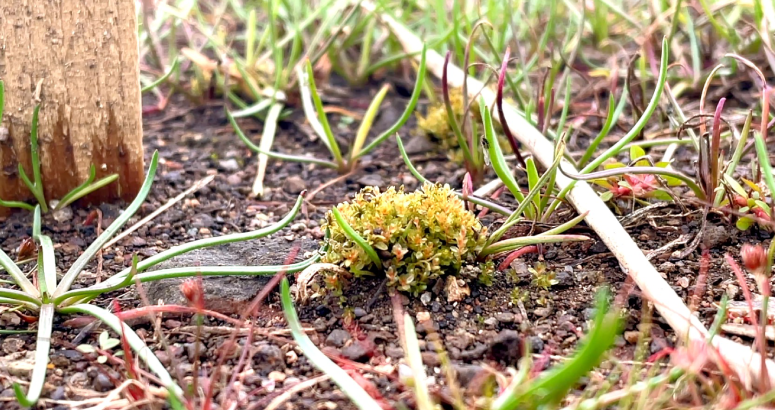Scotland's Rarest Moss Finds New Home at Stirling Reservoirs
18 September 2025Translocation
It is hoped the extremely rare species of moss will thrive under the right conditions at Scottish Water's North Third and Loch Coulter reservoirs.
An extremely rare moss which has only been found in one place in the UK in the last 30 years has now been moved to two Scottish Water reservoirs in a bid to revive the critically endangered species.
Round-leaved bryum, a moss which lives in the mud and is only revealed when water levels in lochs and reservoirs are low, was identified by Royal Botanic Garden Edinburgh’s David Chamberlain at Threipmuir Reservoir, near Balerno, Edinburgh in December 2023.
Since then, NatureScot and RBGE have been working together to grow and translocate the rare moss to Scottish Water’s North Third and Loch Coulter reservoirs, near Stirling, which were found to have the right conditions for the moss to survive.
RBGE took a sample of the moss and grew the bryum population from around 13 small clusters of shoots to a population big enough to transplant out.
RBGE horticulturist Rebecca Drew designed a trial to assess the correct ecological conditions that were required to cultivate the species. With the help of students, they worked with precious material to learn and understand the bryum’s requirements for optimal growth.
Now, thousands of shoots are growing in a specially designed artificial mud habitat created within the Garden’s Nursery site, bolstering numbers for translocation. Ongoing maintenance of this collection has been done with extreme care, carefully weeding the tiny plants to ensure there was no competition from other mosses and that the patches were pure bryum for planting out.
Aside from Threipmur reservoir, which forms part of the Balerno Common Site of Special Scientific Interest (SSSI), there has not been a confirmed ID of round-leaved bryum anywhere else in the UK since 1987.
In the UK this moss has only been seen to reproduce by cloning itself, which has limited its ability to reach new sites. This means it is losing sites faster than it is gaining new ones, contributing to its decline.
NatureScot’s Bryophyte, Fungi and Lichen Adviser, Kat O’Brien said: “We don’t often translocate mosses or lichens as it’s always best to preserve rare species in their current habitat. They are also very picky about the conditions they need and frequently fail to thrive in their translocated sites.
“But in this case, the round leaved bryum is unlikely to spread naturally and has biological features that make it easier to cultivate and translocate well. We’re hopeful that our efforts will give this incredibly rare moss the boost it needs to survive, and we’ll be monitoring the moss for the next five years to see if it has successfully become established.”
Rebecca Drew, Scottish Native Plant Horticulturist at the Royal Botanic Garden Edinburgh added: “Bryophytes such as the round-leaved bryum are often overlooked, but they are an integral part of the biodiversity of Scotland.
“In order to help save this critically endangered moss, we had to remove it from its natural habitat and into the research and growing facilities at our Nursery site. There, through our expertise in conservation horticulture, we were able to cultivate this extremely rare species to the point where it has now been moved into safe new sites, giving it a chance of survival and securing the species for the future.”
Technical team manager at Scottish Water, Euan Innes, said: “We are really pleased to have been able to work with NatureScot and RBGE to find suitable sites to host this very rare species and hope that the moss is able to thrive in its new homes.
“It represents a big positive for Scottish biodiversity, something which Scottish Water is focused on cultivating across its landholdings and is also a great example of joined up partnership working amongst the organisations involved.”
There are 900 different of species of moss in Scotland, and round leaved bryum is just one of our many rare species. Mosses and liverworts are thought to be similar to the very first plants that evolved and they can live in a wide variety of habitats. Some can anchor themselves onto trees (without damaging the bark), others can live on the dry expanses of roof tiles, and some can even live on mine spoil that would be toxic to non-specialist plants.
Round-leaved bryum, a moss which lives in the mud and is only revealed when water levels in lochs and reservoirs are low, was identified by Royal Botanic Garden Edinburgh’s David Chamberlain at Threipmuir Reservoir, near Balerno, Edinburgh in December 2023.
Since then, NatureScot and RBGE have been working together to grow and translocate the rare moss to Scottish Water’s North Third and Loch Coulter reservoirs, near Stirling, which were found to have the right conditions for the moss to survive.
RBGE took a sample of the moss and grew the bryum population from around 13 small clusters of shoots to a population big enough to transplant out.
RBGE horticulturist Rebecca Drew designed a trial to assess the correct ecological conditions that were required to cultivate the species. With the help of students, they worked with precious material to learn and understand the bryum’s requirements for optimal growth.
Now, thousands of shoots are growing in a specially designed artificial mud habitat created within the Garden’s Nursery site, bolstering numbers for translocation. Ongoing maintenance of this collection has been done with extreme care, carefully weeding the tiny plants to ensure there was no competition from other mosses and that the patches were pure bryum for planting out.
Aside from Threipmur reservoir, which forms part of the Balerno Common Site of Special Scientific Interest (SSSI), there has not been a confirmed ID of round-leaved bryum anywhere else in the UK since 1987.
In the UK this moss has only been seen to reproduce by cloning itself, which has limited its ability to reach new sites. This means it is losing sites faster than it is gaining new ones, contributing to its decline.
NatureScot’s Bryophyte, Fungi and Lichen Adviser, Kat O’Brien said: “We don’t often translocate mosses or lichens as it’s always best to preserve rare species in their current habitat. They are also very picky about the conditions they need and frequently fail to thrive in their translocated sites.
“But in this case, the round leaved bryum is unlikely to spread naturally and has biological features that make it easier to cultivate and translocate well. We’re hopeful that our efforts will give this incredibly rare moss the boost it needs to survive, and we’ll be monitoring the moss for the next five years to see if it has successfully become established.”
Rebecca Drew, Scottish Native Plant Horticulturist at the Royal Botanic Garden Edinburgh added: “Bryophytes such as the round-leaved bryum are often overlooked, but they are an integral part of the biodiversity of Scotland.
“In order to help save this critically endangered moss, we had to remove it from its natural habitat and into the research and growing facilities at our Nursery site. There, through our expertise in conservation horticulture, we were able to cultivate this extremely rare species to the point where it has now been moved into safe new sites, giving it a chance of survival and securing the species for the future.”
Technical team manager at Scottish Water, Euan Innes, said: “We are really pleased to have been able to work with NatureScot and RBGE to find suitable sites to host this very rare species and hope that the moss is able to thrive in its new homes.
“It represents a big positive for Scottish biodiversity, something which Scottish Water is focused on cultivating across its landholdings and is also a great example of joined up partnership working amongst the organisations involved.”
There are 900 different of species of moss in Scotland, and round leaved bryum is just one of our many rare species. Mosses and liverworts are thought to be similar to the very first plants that evolved and they can live in a wide variety of habitats. Some can anchor themselves onto trees (without damaging the bark), others can live on the dry expanses of roof tiles, and some can even live on mine spoil that would be toxic to non-specialist plants.

Monitoring
The moss will be monitored for the next five years to see if it becomes established at the new sites.








